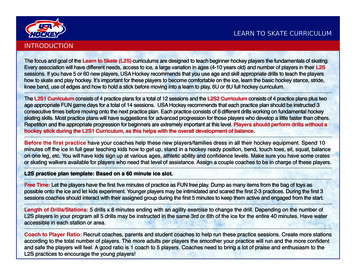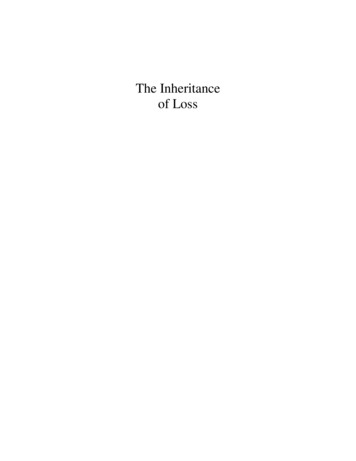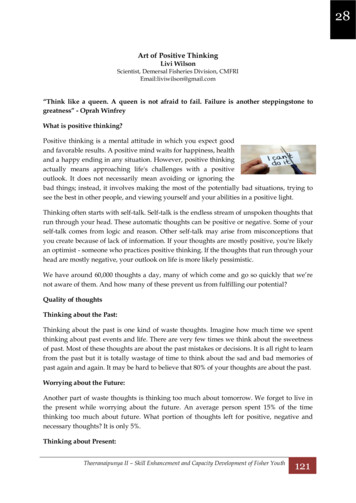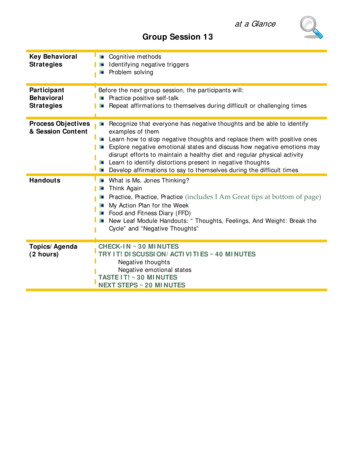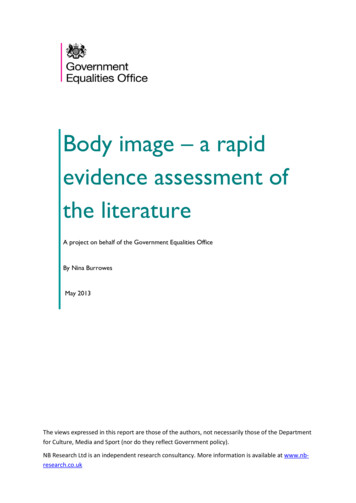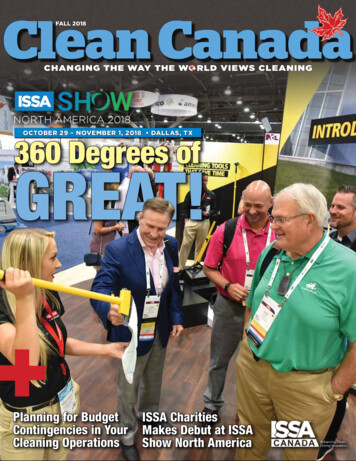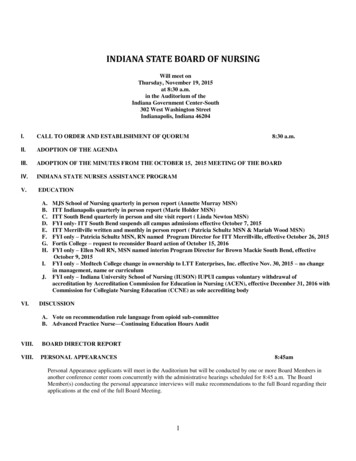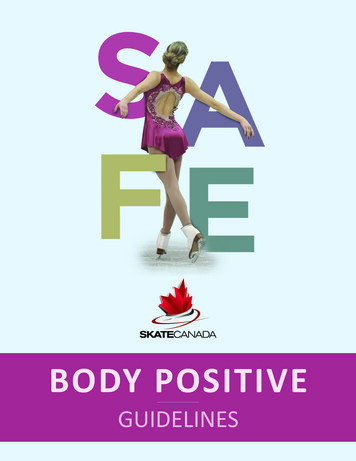
Transcription
BODY POSITIVEGUIDELINES1
TABLE OF CONTENTSIntroduction. . . . . . . . . . . . . . . . . . . . . . . . . . . . . . . . . . . . . . . . . . . . . . . . . . . . . . . . . . . . . . . . . . . . . . . 3Background / Rationale. . . . . . . . . . . . . . . . . . . . . . . . . . . . . . . . . . . . . . . . . . . . . . . . . . . . . . . . 3What is body Image?. . . . . . . . . . . . . . . . . . . . . . . . . . . . . . . . . . . . . . . . . . . . . . . . . . . . . . . . . . . 3Positive Body Image. . . . . . . . . . . . . . . . . . . . . . . . . . . . . . . . . . . . . . . . . . . . . . . . . . . . . . . . . . . . . 3Growth and Development. . . . . . . . . . . . . . . . . . . . . . . . . . . . . . . . . . . . . . . . . . . . . . . . . . . . . . . 4Body Composition Assessments. . . . . . . . . . . . . . . . . . . . . . . . . . . . . . . . . . . . . . . . . . . . . . . . 5Nutrition. . . . . . . . . . . . . . . . . . . . . . . . . . . . . . . . . . . . . . . . . . . . . . . . . . . . . . . . . . . . . . . . . . . . . . . . . . . 5Training. . . . . . . . . . . . . . . . . . . . . . . . . . . . . . . . . . . . . . . . . . . . . . . . . . . . . . . . . . . . . . . . . . . . . . . . . . . . 6Communication and Language. . . . . . . . . . . . . . . . . . . . . . . . . . . . . . . . . . . . . . . . . . . . . . . . 6Prevention. . . . . . . . . . . . . . . . . . . . . . . . . . . . . . . . . . . . . . . . . . . . . . . . . . . . . . . . . . . . . . . . . . . . . . . . . 7Acknowledgements. . . . . . . . . . . . . . . . . . . . . . . . . . . . . . . . . . . . . . . . . . . . . . . . . . . . . . . . . . . . . . 8References. . . . . . . . . . . . . . . . . . . . . . . . . . . . . . . . . . . . . . . . . . . . . . . . . . . . . . . . . . . . . . . . . . . . . . . . 9Appendix A: Resources for Education, Intervention and Treatment. . . . . 11Appendix B: Guide for Navigating Body-Related Athlete Concerns. . . . . . 122
INTRODUCTIONOne of Skate Canada’s goals is a commitment to athletehealth, performance, and wellbeing. Foundationalto this goal is ensuring that all participants have anenvironment that is safe and inclusive. Skate Canadastrives for excellence in competitive success and setsa high priority on ensuring physical, psychological, andemotional safety and wellbeing for its members. As aresult, Skate Canada aims to be a national and worldleading safe sport organization. The Body PositiveGuidelines are essential to ensure that everyone withinthe organization has a clear understanding of whatfactors can impact body image, how changes unfoldwith growth and development, and that everyoneinvolved with the athlete can promote a healthy andsafe training and competition environment.All athletes, coaches, families, officials, volunteers, andstaff should have a training or working environmentwhere individuals and their bodies are spoken to,spoken about, and treated with care and respect. Thelanguage we use towards our body and the bodiesof others can have a large impact on the perceptionsand feelings an individual may hold about their body.Frequently, these perceptions and feelings can impactan individual’s overall wellbeing, psychological, andphysical health.These guidelines aim to set boundaries on what isacceptable practice, language and behaviour forcoaches, parents, officials, volunteers, and staff whenworking with athletes of all ages, genders, and skatingabilities. These boundaries apply to environmentsthat are inclusive of, but not limited to, the dailytraining environment, training camps, team travel,and competitions. The Body Positive Guidelinesare an important tool to facilitate the creation ofpositive, inclusive, and respectful environments for allathletes, and are in line with Skate Canada’s NationalSafe Sport Program. Creating training and competitionenvironments that are concerned with the promotionof athlete wellbeing will also prove beneficial for theemotional, psychological, and physical health of ourathletes outside the world of sport.Figure skating has struggled with issues associated withbody image and disordered eating due in part to sportperformance demands, the nature of a judged aestheticsport, and thoughts and feelings about the body of anathlete. Rarely are there clear-cut answers and thereis no one size fits all approach when tackling theseissues. Despite the best of intentions, words, actions,information, and advice can be potentially damaging tothe athlete’s wellbeing, development, and performance.The goal of this document is to provide guidelineswhen dealing with these sensitive topics and issuessurrounding the body.Skate Canada recognizes that shifting the mindset andlanguage of individuals can be challenging. However,it is vital to ensure that appropriate communicationoccurs around these topics to improve training andcompetition environments for all athletes.BACKGROUND / RATIONALEThis document is a work in progress. As research continuesto further the understanding of body image in sport, thisdocument will evolve with new knowledge in the field.The Body Positive Guidelines are available publicly.These guidelines should be reviewed annually andbe adhered to by all Skate Canada stakeholders. Itis expected that Skate Canada as well as all clubs,schools, and sections make every reasonable effortto align their culture, programs, and behaviours withthe recommendations contained in the Body PositiveGuidelines. This document and further education inthis area is critical to ensure that the sport of figureskating offers a safe and positive environment for allparticipants to have positive experience and to reachtheir potential.WHAT IS BODY IMAGE?Body image refers to thoughts, feelings, beliefs,attitudes, and behaviours an individual holds towardstheir body (Cash, 2004). Body image is made up ofmany distinct features; however, most discussed arepositive and negative body image. The Body PositiveGuidelines hope to aid in fostering positive body imagewhile minimizing negative body image.POSITIVE BODY IMAGETo promote positive body image, it is important tounderstand the components of both positive andnegative body image. According to experts (WoodsBarcalow et al., 2010), positive body image includes:3
The appreciation of one’s unique body andfunctions.an individuals’ psychological and physical health as wellas their performance (Streigel-Moore & Bulik, 2007). Acceptance of one’s body. Emphasis on one’s body’s assets rather thanimperfections. The interpretation of information about andtowards one’s body in a positive way.Body image concerns are primarily an issue for youngpeople (13 to 24 years of age) (DSM-5, 2013). Given theearly specialization required in figure skating, athletesmay find themselves at an increased risk. Negative bodyimage and disordered eating can affect males as well asfemales and as such, there should be sensitivity acrossall genders.Feeling comfortable, confident, and happy withone’s body.Research has shown that positive body image isprotective against certain negative physical andpsychological health factors (Gillen, 2015). Positive bodyimage has been seen to increase self-care behaviours,is associated with higher levels of self-esteem, and isalso related to a decrease in depressive symptoms. Inaddition, positive body image can also protect againstfactors associated with harmful dieting behaviours anddisordered eating (e.g. body dissatisfaction and drive forthinness) (Gillen, 2015).Negative body image can be conceptualized asdissatisfaction, preoccupation, concern, or distressabout one’s body (Thompson et al., 1999). Individualsexperiencing negative body image are at an increasedrisk for emotional distress, negative self-consciousemotions, and disordered eating attitudes (Thompsonet al., 1999).Athletes are at an increased risk for experiencingnegative body image especially those in aesthetic sportssuch as figure skating, gymnastics, and diving (Greenleaf,Petrie, Carter & Reel, 2009). Due to the demands ofthe sport (form fitting uniforms, judged components,etc.) an individual’s body is often on display. As a result,athletes may experience scrutiny about their bodiesfrom coaches, judges, family members, and peers(Petrie & Greenleaf, 2012). In addition, there may be acontrast between how an athletes’ body looks for sportperformance compared to how it fits with unrealisticand unattainable societal beauty standards (Petrie& Greenleaf, 2012). We are bombarded with imagesthrough TV, magazines, social media, and advertisingthat promote unrealistic, unobtainable, and highlystylized appearance ideals. At times, those who donot feel as though they meet those standards mayexperience symptoms associated with negative bodyimage (body dissatisfaction, self-conscious emotions,disordered eating, etc.) which are often detrimental toIt is recommended that experienced professionals(outlined in Appendix A) be involved to support themental and physical delivery of training, conditioning,nutrition, mental performance, and rest and recovery.Addressing the circumstances of athlete physicalappearance and weight management are extremelydifficult and sensitive and there is no straightforwardanswer. There are several things to consider andimplement to achieve the best outcome for thehealth and wellbeing of the skater. Understanding thedevelopmental age of the athlete, their fueling andnutrition habits, planned and purposeful training andassessments will help to support a positive body image.GROWTH AND DEVELOPMENTGrowth, maturation and development, somethingall individuals experience, is a complex interactionof hormones, nutrients, and genetics. Pubertyis characterized by numerous physical changesincluding height, deposition of fat, bone and muscle,transformation of the brain and acquisition of secondarysex characteristics (Wheeler, 1991). The rate of a child’sgrowth has significant implications to their physicaltraining, both positive and negative. It is not unusual forperformance to be affected by these changes. For moreinformation about growth and development, refer tothe Canadian Sport for Life Long-Term Developmentin Sport and Physical Activity resource and SkateCanada’s Guide to Long-Term Development.It should be recognized that weight gain and/or changesin body composition is a natural part of growth anddevelopment. The development of the athlete’s body isinfluenced through a combination of genetics, training,nutrition, and the environment. If concerns arise aboutan athlete’s growth, coaches should refer the athlete toa qualified professional – physician, sport dietitian, etc. –who will consult with the athlete (see Appendix A).4
BODY COMPOSITION ASSESSMENTSmonitoring of nutrition plans, it is important to seek aqualified nutrition professional (see Appendix A).The primary purpose for body composition assessmentis to measure growth and development of the athleteand to monitor changes as it relates to training andperformance. Such measures can be used to providea complete picture of an athletes’ current growthand maturation so training, competition and recoveryprograms can be appropriately designed based ondevelopmental age not just chronological age ofthe athlete. For mature athletes, body compositionmeasures can be used to help guide programming bothon and off ice to optimize performance (Balyi et al.,2013).There is significant difference between promoting healthyeating and promoting restrictive eating. Individuals maybe involved in specific nutrition plans that monitor theirfood consumption. While these nutrition managementplans are sometimes necessary, when taken to an extremethey may promote disordered eating behaviours and bedetrimental to psychological wellbeing.Body composition assessments may include themeasurement of height, weight, limb lengths, bonebreadths, arm span, girths and/or skinfolds. All bodycomposition measures should only be conducted byan experienced and certified anthropometrist (seeAppendix A). This testing should only be conducted afterthe delivery of an adequate education session and oncewritten consent has been received from the athlete and/or parent/guardian if the athlete is under the age of 18.It is recommended that for athletes under the age of 16,body composition measures are used to monitor growthand development. The objective of body compositionassessments for athletes that are over the age of 16 isto continue to monitor growth and development alongwith health and performance.Skate Canada does not condone coaches or staffweighing athletes in the daily training environment.A health professional or anthropometrist shouldbe the only person who monitors weight and bodycomposition.Appropriately fueling the body ensures an athlete canmanage various training load, adapt to phases of trainingcycles, and meet the competition demands of a season. Ifan athlete’s energy consumption is insufficient, the impacton performance can be profound. Not only is performanceimpacted, but more importantly, many necessary healthfunctions of the body are impaired due to under fuelling(i.e. bone health, cardiovascular function, menstruation,immunity). The Female Athlete Triad and Relative EnergyDeficiency in Sport (RED-S) are syndromes that outlineconsequences of low energy availability (King, 2005). Thediagrams below illustrate health consequences of bothRED-S and the Female Athlete Triad (Mountjoy et al, 2014).While the Female Athlete Triad currently addresses theimpact on bone, menstrual function and eating issues infemales, RED-S addresses that any athlete can experiencethe negative consequences of under fuelling (i.e. bothmales and females). RED-S also explains how low energyavailability may impair other systems in the body andperformance.Figure 1. Health Consequences of Relative Energy Deficient in SportNUTRITIONProper nutrition and adequate fueling is critical for anathlete’s growth and maturation, overall health, andperformance. If there are ever any concerns about anathlete’s nutrition plan or eating habits it is imperativeto consult with a qualified nutrition professional (seeAppendix A). There is ever-growing information andmisinformation regarding nutrition that is easy to accessand misuse. Athletes are often caught between conflictingphilosophies on food, nutrition, and how to fuel theirbodies for sport. For proper guidance on the creation and5
Figure 2. Symptoms of the Female Athlete Triad placed within RED-STRAININGSkaters must combine a diverse range of skills withincreasing levels of technical difficulty and presentationfor the duration of a 2-4 minute program. To masterthe technical difficulties and complete the volumeof training required to be competitive, skaters mustcontinue to make advances in their physical capabilities,such as cardiovascular fitness, flexibility, strength, andpower (King, 2005) as deemed appropriate for theirlevel of growth and maturation (refer to Skate Canada’sGuide to Long-Term Development). As a result, off-icetraining should be structured based on developmentalage rather than chronological age.Off-ice training (including but not limited to strength,speed, stability, cardiovascular, and recovery modalities)may assist in the mitigation of injuries that can be arepercussion of the large number of jumps, lifts andspins that are part of daily on-ice training. Developingsound structural tolerance, or the athlete’s ability towithstand the impact of daily training, can be a keycomponent in maintaining the health of the skaterand extending the longevity of the athlete’s career.The volume of off-ice training should be monitoredto ensure that the overall load on an athlete is stillappropriate for the age and maturation status of theathlete.COMMUNICATION AND LANGUAGEDisordered eating refers to a continuum of maladaptivefeeding and eating behaviours that include dieting,restrictive eating, sub-clinical, and clinical eatingdisorders. It can often be difficult to identify if anathlete is experiencing disordered eating or is strugglingwith negative body image as the symptoms are notalways visible to those around. It is not simply theeating behaviours that are of concern regardingdisordered eating, but rather the thoughts, feelings,and perceptions about the body that can motivate thisbehaviour. The ideas an athlete may hold about theirbody can be heavily influenced by those around them.Though usually well intentioned, comments made bypeers, coaches, parents, officials, and staff can holdenormous amounts of influence (McCann, 2007). Withthis in mind, it is important to be mindful about the wayin which we speak about and towards an individual andtheir body. For example, a casual comment of: “athleteA has the perfect body for skating” could be interpretednegatively and could result in an athlete believing thatto be successful that is the only body type accepted.All adults and especially coaches have tremendouspower over the athlete(s), do not underestimate theinfluence that you have. As outlined in the National SafeSport Policy please review the definitions of harassmentand bullying:Bullying (and/or abusive behaviour) meansunwanted physical, verbal or psychological acts,or other objectional conduct (in person and/oronline/cyberbullying) by a person, deliberately orsubconsciously, that is intended to ridicule, belittle,alienate or humiliate another person irrespectiveof the persons’ hierarchical position with relationto the other person.Harassment means any vexatious comments,conduct, behaviour, actions or gestures that arecommitted, threatened or attempted againstanother person that are insulting, intimidating,demeaning, malicious or offensive, where theperson knows or ought reasonably to know thatsuch behaviour or comments are unwelcome,including but not limited to sexual harassment,and criminal harassment as defined in the CriminalCode in force and effect and as amended fromtime to time, which includes prohibited conduct6
that causes the other person reasonably, in thecircumstances, to fear for their safety or the safetyof anyone known to them.As indicated throughout this document, the intent is todo no harm. As a result, it is essential that everyone bevigilant in the awareness of the comments and feedbackthat is provided to the athlete(s).All individuals/bodies are to be addressed with respectand harmful language is to be avoided. Examples of howto give a factual, performance-based feedback, ratherthan commenting on the skater’s physical appearancecan be found in Appendix B. Below are some practicalrecommendations of appropriate communication andlanguage.1. Every reasonable effort must be made to avoiddirectly critiquing or commenting on the physicalappearance, shape, size, or weight of an athlete –regardless of whether it is believed to be “true”or “helpful”. Consider ways to communicatemore functional, or supportive messages whichencourage all athletes to care for and listen totheir bodies.2. Words like “fat”, “overweight”, “large”, “heavy”,“skinny”, or “stick thin”, can be hurtful and shouldnot be used to describe an athlete’s body (andother terms related to body shaming/bullying).Moreover, words like “toned” and “lean” canalso perpetuate body preoccupation and shouldbe avoided. These terms are not to be used tocommunicate directly to or about the athlete.Language and word choices have an impact.Use words sensitively and non-judgementally.Focus on performance and fitness rather thanappearance and weight.3. Both praise and criticism for body appearance,shape, size, or weight may be harmful. Avoidcommenting on bodies, and instead praise skill,execution, power, strength, effort, persistence, orother attributes that are not appearance-based.4. Conversations about athlete’s bodies (regardlessof whether this is praise or criticism) in front ofother individuals, are to be avoided. Comparisonsare not constructive and can be harmful to theathlete in question, as well as to any other athletewho may hear the conversation.5. Avoid conversations with coaches or staff aboutbodies or eating habits of athletes or staff, in frontof athletes. These conversations for performanceand/or wellbeing, should be kept private andinvolve the appropriate health professional (seeAppendix A).6. Be aware that as an individual in a position ofpower, the thoughts and feelings about your body,food consumption, weight and how you speakabout them will impact others around you. Avoiddiscussing personal details with athletes.7. Please consider that the delivery of a comment and/or message may be received differently to howit is intended. Individuals should be thoughtfuland considerate about personal circumstances,cultural differences, characteristics, and experiencesof each individual, which may influence theinterpretation of the message.PREVENTIONThere are many things that can be done to reducedisordered eating and promote positive body imagein sport. Given that body image is a complex issuemade up of many factors, different approaches andresources for prevention should be considered. Thesecan range from screening tools, nutrition planning,educational resources, and self-compassion workshops.Due to the complexity of body image in sport, a unifiedfront to decrease the risk of negative body image anddisordered eating in our athletes requires buy in fromofficials, staff, coaches, parents, and teammates.Athletes should annually receive a pre-participationexamination performed by a qualified sport medicinephysician (IOC, 2009). This is the best way to detectany potential medical conditions and reduce the risk ofpotential health issues with a growing athlete.Furthermore, there are important factors that can helpto promote positive athlete growth such as:1. Positive, person oriented coaching style.2. Positive social influence and support fromteammates, coaches, families, officials, and staffwith healthy attitudes towards every size andshape.3. Coaches who emphasize factors that contributeto personal success, such as motivation and effortrather than body weight or shape.7
ACKNOWLEDGEMENTSIf you have questions regarding these guidelines, please contact Skate Canada’s safe sport departmentat safesport@skatecanada.ca or 1-888-747-2372 ext: 703.The Body Positive Guidelines have been developed by Skate Canada in consultation with theIntegrated Support Team (IST) with contribution by:Anna AylwinKelly DragerGeorgia Ens, PhD StudentJudy Goss, PhDDr. Tatiana JevremovicAgnes MakowskiKelly QuippSkate Canada would like to extend its genuine thanks to the listed individuals for their contribution tothe sport and their concern for the wellbeing of the athletes.In addition, Skate Canada would like to acknowledge Gymnastics Australia and Dietitian FionaSutherland, for providing the framework for the guidelines.Given the purpose of these guidelines, language in this document is used with the intention tohighlight and focus on an individual’s body. The body is only one aspect of an individual’s self concept.As such, language used purposefully centres the body throughout the document.In addition, this document does not address body image concerns specifically for athletes withdisabilities. As this is a growing and changing document, including needs for this specific populationmay be included in future iterations.8
REFERENCESAmerican Psychiatric Association. (2013). Diagnostic and statistical manual of mental disorders (DSM5 ). American Psychiatric Pub.Balyi and C. Williams (Eds.) Coaching the young developing performer. (pp. 74-86). Leeds: Coachwise.Bonci, C., Bonci, L., Granger, L., Johson, C., Malina, R., Milne, L., & Vanderbunt, E. (2008). NationalAthletic Trainers Association position statement: preventing, detecting, and managingdisordered eating in athletes (position statement) (Report). Journal of Athletic Training, 43(1),80-108.Bratland-Sanda, S. & Sundgot-Borgen, J. (2013). Eating disorders in athletes: Overview of prevalence,risk factors and recommendations for prevention and treatment. European Journal of SportScience, 13(5), 499-508.Cash, T. F. (2004). Body image: Past, present, and future.Coppola, A.M., Ward, R.M., & Freysinger, V.J., (2014). Coaches’ communication of sport body image:Experiences of female athletes. Journal of Applied Sport Psychology, 26(1), 1-16.DeSouza, MJ., Nattiv, A., Joy, E., Misra, M., Williams, NI., Mallinson, R., Gibbs,s JC., Olmsted, M.,Goolsby, M., Matheson, G., & Expert Panel. (2014). 2014 Female Athlete Triad CoalitionConsensus statement on treatment and return to play of the Female Athlete Triad. BritishJournal of Sports Medicine, 48: 289.Greenleaf, C., Petrie, T. A., Carter, J., & Reel, J. J. (2009). Female collegiate athletes: Prevalence ofeating disorders and disordered eating behaviors. Journal of American College Health, 57(5),489-496.Gillen, M. M. (2015). Associations between positive body image and indicators of men’s and women’smental and physical health. Body image, 13, 67-74.King, (2005). IOC consensus statement on relative energy deficiency in sport (RED-S): 2018 update.McCann, S. (2007). How coaches can talk to their female athletes about nutrition and weight control.US Olympic Coach magazine, 18(4), 18-20.Mountjoy, M., Sundgot-Borgen, J., Burke, L., Carter, S., Constantini, N., Lebrun, C., Meyer, N., Sherman,R., Steffen, K., Budgett, R., & Ljunfgvist, A. (2014). The IOC consensus statement: beyond thefemale athlete triad – Relative Energy Deficiency in Sport (RED-S). British Journal of SportsMedicine, 48, 491-497.Petrie, T. A., & Greenleaf, C. (2012). Eating disorders in sport. In S. M. Murphy (Ed.), Oxford library ofpsychology. The Oxford handbook of sport and performance psychology (pp. 635-659). NewYork, NY, US: Oxford University PressStriegel-Moore, R. H., & Bulik, C. M. (2007). Risk factors for eating disorders. American psychologist,62(3), 181.The International Olympic Committee (IOC) consensus Statement on Periodic Health Evaluation ofElite Athletes, March 2009.9
Thompson, J. K., Heinberg, L. J., Altabe, M., & Tantleff-Dunn, S. (1999). Exacting beauty: Theory,assessment, and treatment of body image disturbance. American Psychological Association.Williams, C. (2009). Tracking growth and development: How to measure PHV.Wheeler, M. D. (1991). Physical changes of puberty. Endocrinology and metabolism clinics of NorthAmerica, 20(1), 1-14.Wood-Barcalow, N. L., Tylka, T. L., & Augustus-Horvath, C. L. (2010). “But I like my body”: Positive bodyimage characteristics and a holistic model for young-adult women. Body image, 7(2), 106-116.10
APPENDIX A:Resources for Education, Intervention and TreatmentThere are many resources that can be tapped into for support regarding body image and disorderedeating in sport. As you are looking for a professional, please do your due diligence in terms of askingabout sport specific experience, certifications as well as education. Information on professionalassistance and education are listed below: To find a sports dietitian in your area consult (use filters such as athlete or d-dietitian?language en US. To find a psychologist in your area consult your provincial psychological association. For example,www.psych.on.ca. To find a mental performance consultant in your area consult: www.cspa.acps.com. When finding a strength and conditioning coach in your area be sure to check their certifications,experience, and ask for references. Athletes coaches and parents support staff can contact Skate Canada at 1-888-747-2372 if theyhave any questions or concerns. Body Image and Sport: https://www.bodysense.ca/tools Self-Compassion: https://self-compassion.org/.To find an anthropometrist: https://www.isak.global/MemberList/Index.To find a sports medicine physician in your area consult: rt-medicine-doctor/.National Eating Disorder Information Centre (NEDIC): https://www.nedic.ca.Canadian Centre for Mental Health in Sport (CCMHS): https://www.ccmhs-ccsms.ca/.Association for Applied Sport Psychology: dy Project Collaborative: http://www.bodyprojectsupport.org/home.11
APPENDIX B:Guide for Navigating Body-Related Athlete Concerns:Examples on how to give a factual, performance-based report, rather than commenting on the skater’sphysical appearance:1. Body composition measurements can be a point of concern or distress for some athletes. Takingsteps to make athletes comfortable with the process is important. Referring to the guidelines,inform athletes about the purpose of the measures using language like “we measure growth andbody composition to make sure you are growing in a healthy way this will help maximize yourperformance and reduce your risk of injury”.2. If an athlete expresses concerns related to negative body image, efforts should be made tonormalize these feelings by letting them know they are not alone in having thoughts like this.While the initial instinct may be to respond to the athlete with comments like “Don’t think likethat”, “You don’t need to be worried about your body” these comments may dismiss the athlete’sfeelings. Instead, statements like “I hear you”, “That must be really difficult” and “What can I do tosupport you” can be followed up with conversations about support systems and resources listed inAppendix A.3. Instead of using words to praise athletes like “toned”, “lean” “shredded” shift the focus toperformance-based compliments like “You look really confident in that skill” or “I can see you havebeen working hard in your off-ice training and it is really paying off in your skating”.4. Often times changes to the body during an athlete’s growth and maturation may impact an athlete’sperformance and ability to execute certain skills. Reassure athletes that changes during puberty arenormal. Support during this already challenging time in a young person’s life is important. Try to beencouraging and accepting. R
Body image refers to thoughts, feelings, beliefs, attitudes, and behaviours an individual holds towards their body (Cash, 2004). Body image is made up of many distinct features; however, most discussed are positive and negative body image. The Body Positive Guidelines hope to aid in fostering positive body image
